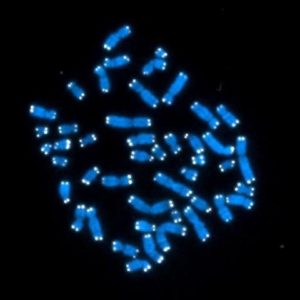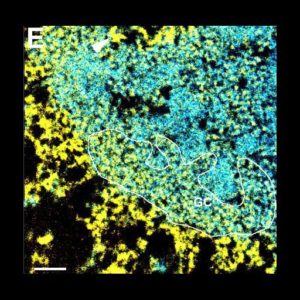A New Biological Aging Clock: Ribosomal DNA
Chronological aging is easy to track – birthdays. Biological aging can be obvious too – graying hair, sagging skin, and other inexorable signs of impending decrepitude. But measuring biological aging isn’t as easy as noting the passage of time.
 The best-studied measure of biological age is the shrinking of chromosome tips, or telomeres, that do so with each division of most types of cells. As soon as I posted “Telomere Testing: Science or Snake Oil?” here at DNA Science, my Facebook feed filled with ads from companies like this one, offering to enlighten me on the status of my chromosome tips.
The best-studied measure of biological age is the shrinking of chromosome tips, or telomeres, that do so with each division of most types of cells. As soon as I posted “Telomere Testing: Science or Snake Oil?” here at DNA Science, my Facebook feed filled with ads from companies like this one, offering to enlighten me on the status of my chromosome tips.
The new biological ticker, the rDNA clock, makes its debut in the latest issue of Genome Research. Meng Wang and Bernardo Lemos, from the Harvard T.H. Chan School of Public Health, term rDNA a “universally applicable marker of aging.” Their article also is a brilliant example of how science is done, with a series of hypotheses and experiments, countering the oft-bellowed mantra that one can “believe in” climate change, evolution, or cell structure.
Hail the Nucleolus
“rDNA” stands for ribosomal DNA. Ribosomes are the roundish structures upon which the amino acids of a protein are strung together, following the instructions of a gene’s DNA sequence. A ribosome is a conglomeration of RNA molecules as well as proteins. The rDNA of the new clock encodes those ribosomal proteins.
Of the 3.2 billion DNA building blocks of a human genome, ribosomal DNA accounts for only 13,000, but its puny representation is not in proportion to its importance. The sections of the genome that encode rDNA aggregate within a cell’s nucleus, forming a dense area called the nucleolus (“tiny nucleus”).
The nucleolus is best known as the headquarters for assembling ribosomes, but the rDNAs do more. They control cellular metabolism, the expression of many genes, genome integrity, the stress response, and aging. Ironically, rDNAs lay beneath the radar of traditional genome sequencing, which picks up single sequences and misses copies.

Another peculiarity of rDNA is that methyl groups (a carbon atom bonded to three hydrogen atoms) silence about a tenth of the repeats by binding “CpG” sites, DNA base couples of cytosine (C) next to guanine (G). Methylation is an epigenetic change to the DNA, altering gene expression but not the actual DNA sequence.
The Mouse Clock Works in People
Drs. Wang and Lemos looked at aging and what happens to rDNA in the cells of mice, dogs, and humans. I assume cats were excluded because their 9 lives would disqualify them from aging experiments.
The first finding: the rDNA in mice becomes more methylated as the animals age, but this isn’t true for methyls bound elsewhere in the genome. Other studies had shown that excess methylation of rDNA is seen in mice whose mothers were malnourished and in the hippocampus of people who died of suicide. So undermethylation is good and life-extending, overmethylation bad.
Next, the researchers tested factors known to affect life span (average length of life for a species).
- Caloric restriction decreased methylation of rDNA, indicating longer life, even in a very long-lived strain of mice. Plus, the underfed rodents showed biological ages (rDNA) younger than their chronological ages.
- Induced pluripotent stem cells made from lung and kidney progenitor cells of mice showed much lower rDNA ages than specialized cells, as expected for more primitive cells.
- The 88 rDNA sites in mice that best predicted longevity also predicted slowed aging in cells from dogs and wolves. Fido can read Mickey’s clock. Mice and canids split 80 million years ago, so the rDNA clock is ancient.
- When the researchers looked at the 88 “clock sites” from the mouse rDNA in white blood cells from healthy adult humans and human embryonic stem cells, the latter were found to be much younger. Again, that’s expected for a less specialized cell type.
- Finally, the mouse clock applied to skin samples from 6 adults sorted the people in order of their chronological ages.
The “Universal Predictor of Individual Age”
A new biological clock could be put to good use. “Determining biological age is a central step to understanding fundamental aspects of aging as well as developing tools to inform personal and public health choices. We have hopes that the ribosomal clock will provide new insights into the impact of the environment and personal choices on long-term health,” said Dr. Lemos.

Some specific applications come to mind:
- assessing the effects of cancer treatments on biological aging, perhaps through a cheek swab test
- detecting how environmental exposures like pollution or factors such as lack of exercise or malnutrition affect biological aging
- determining the age structure of a natural population, perhaps through feces analyses
- estimating the age of a stray cat or dog. The animal shelter deemed our new cat Milton as 3, based on his teeth. Might his rDNA provide a more accurate assessment? This approach could be extended to checking the age of humans.
- manufacturers of cosmetics and skin care products can combine rDNA with SPF measurements to dole out dollops customized to how long a customer has until wrinkles appear.
A New Bio Buzzword Company?
I’m sure someone will try to commercialize the new rDNA clock. But because “microbiome” took so many years to join the lexicon of advertising, it may be awhile.
 A company might capitalize on the popularity of “epigenetics” or even better, “epigenomics.” Tee shirts could sport nucleoli. Branding could be a problem though, for biologists are well known for coming up with pathetic, unpronounceable acronyms: RFLPs; VNTRs; GWAS? SNPs were a happy snappy accident.
A company might capitalize on the popularity of “epigenetics” or even better, “epigenomics.” Tee shirts could sport nucleoli. Branding could be a problem though, for biologists are well known for coming up with pathetic, unpronounceable acronyms: RFLPs; VNTRs; GWAS? SNPs were a happy snappy accident.
For the new clock, the researchers dub the prophetic process of ribosomal DNA methylation “rDNAm.” Rdamn? I’m stymied.
Suggestions anyone?

“Suggestions anyone?”
Thanks for asking.
Link the light-activated assembly of the microRNA-RNA-peptide #nanocomplex to all biodiversity via Greg Bear’s works and his creation of a new human species.
Can you elaborate? I love Greg Bear. Has he published anything recently?
Ricki, you predicted it right. We started a company around it called Epigenetica.com. I see you have a cat, how would you like us to test what cat food makes your kiddy live longest ? We got the request from a major cat food company to test their food. Give me a call if you like to know more. I am just the business guy but Bernardo can answer any science questions you may have. We are still raising seed capital but are already doing some saliva tests on humans.
Thanks for getting in touch and for reading my post. We have four cats, all FIV+, so I’m not sure that predicting their lifespan would be possible, infections are unpredictable. What are you testing the food for?